|
|
|
|
The Norfolk Coast
|
| The coastline of Norfolk, which is skull-shaped,
protrudes into the North Sea - where it is exposed
to the full force of wind and wave. Running for nearly
100 miles, it consists of a wide variety of terrains
including: cliffs, beaches, sand dunes, salt-marshes, mudflats,
shingle banks and spits. Over the centuries it has
inspired countless writers - with its constantly
changing light, its unpredictable tides and its bleak beauty. Even
today, despite an influx of tourists, it still contains a wild
and unspoilt quality.
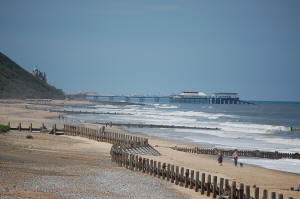
Overstrand Beach
On its western edge, it begins on the remote mudflats of the Wash - before
heading eastwards towards the town of
Kings Lynn. Steeped in
maritime history, Lynn is one of Norfolk's best kept
secrets. Once part of the Hanseatic League it
possesses a wealth
of historic buildings - most of them clustered around
the quayside. In his poem King's
Lynn R.N. Curry invites us to:
'Explore now, as a freak wave might explore/This town that history
could have made a city'. From Lynn the coastline
veers northwards along the eastern side of the Wash past
the ancient town of Castle Rising and the Queen's
favourite retreat at Sandringham to
Snettisham -
famous for its RSPB reserve. The Manx poet David Callin
visited the area and wrote a moving poem called
Snettisham which begins:
|
This is the Wash
it seems -
a last exhalation
of the dying land, or something
the sea's been working on
for ages: sketching it in,
rubbing it out,
redoing and redoing it,
never satisfied. |
|
At
Hunstanton, cliffs appear
for the first time - but these are
no ordinary cliffs - but strikingly striped ones composed
of red and white chalk and carr-stone. L.P. Hartley used them
as a backdrop in his novel The Shrimp and
the Anemone and in Patrick Hamilton's novel Rope
the first chapter
opens with George Harvey Bone walking along them. And according to the poet
Andrew McDonnell, Hamilton's fictional character is
still haunting the town today - see
George Harvey
Bone.
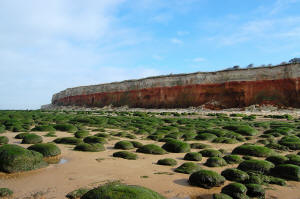
Cliffs at Hunstanton
Rounding the north western tip of the county - the cliffs subside - and the
sand dunes and beaches of
Holme-next-the-Sea take over.
This is a
location familiar to the nature writer
Patrick Barkham who used to come with his father on
family holidays. Together they would search for
butterflies - an activity which sparked a life-long
interest and ultimately resulted in his book The
Butterfly Isles (2010).
Sheltering behind Scolt Head Island lies
Brancaster - which was once a Roman
settlement. Lord Nelson
learnt to sail in the creeks here and the stunning beach inspired both the novelist Angela Huth
in Invitation to the Married Life and also the poet John Gallas
in his poem
Sunrise on Brancaster
Beach where he notes: 'The sea looks white,/
like gnawed skin; the wrinkled sand feels cold.'
Burnham Overy
Staithe, where the tiny River Burn reaches the sea,
has always provided inspiration for the poet and
children's writer Kevin Crossley-Holland - particularly
in the 25 poems which make up his Waterslain collection where
he depicts characters from the village.
Heading along the coast road, we then pass the
Holkham estate - with its
magnificent Paladian mansion and landscaped parkland. Another spectacular
beach here was used by filmmakers in
Shakespeare in Love and the wild swimmer Roger Deakin took a dip
here and recorded it in his delightful book Waterlog. Entering the narrow, flint-walled
street of Stiffkey -
history seems palpable. It was here in 1937 that the
writer Henry Williamson tried his hand at farming and recorded
the ups and downs
in The Story of a Norfolk Farm. While in the
county, he also
collaborated with Lilias Rider Haggard, the daughter of
Henry Rider Haggard, to produce the ever-green
Norfolk Life. Next
comes the tiny village of Morston - famous today for its seal tours and
fine food. The poet Edwin Brock (who lived at Low
Tharston next door to another poet Anthony Thwaite)
wrote a beautifully
haunting poem called
Morston Marshes
- which captures the transience of the tides and the
isolated beauty of the place.
|
Into this muddy
coastline
the North Sea seeps silently
twice a day
under the kestrel's weather eyein the growing puddles
gulls drill the marsh
for nothing we can see
or screech their territory
like fishwives
from the tops of poles
|
|
At
Blakeney the famous four-mile
long sand spit known as Blakeney Point curves round protecting an area of dunes and salt marshes
from the ravages of the North Sea. The town itself was once a wealthy port,
but declined when its harbour
silted up. The poet Thomas Thornely wrote a fine lament
about the loss of its trade entitled
Blakeney.
The
author Jack Higgins stayed at the Blakeney Hotel in the 1970s
while researching and writing his WW2 novel
The Eagle Has Landed about the
assassination of Winston Churchill. He drew on a number
of locations - including St Mary's Church at Cley -
for his fictional Studley Constable.
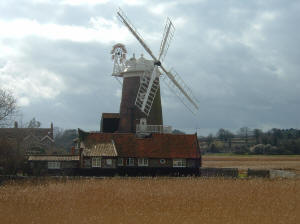
Cley Windmill The charming village of Cley-next-the-Sea
is renowned for its nature reserve, its church
and its splendid windmill. Many bird watchers come here
and stay at the
George Hotel. My own poem
Ornithologist hopefully captures something of
the spirit of the place.
|
|
At
Salthouse a fragile shingle
bank protects the village from flooding - but it is
regularly breached - as in 1953 and 2014. The precarious existence
of the villagers is captured in a
bleak but beautiful poem by John Press entitled
Salthouse,
Norfolk. The village originally got its name from the salt
it produced and exported to the
continent.
A short walk along The Quag, past Kelling Hard,
brings you to the steep, shingle beach at Weybourne where cliffs suddenly reappear.
Composed of sand and gravel deposited by a melting glacier
- they offer little resistance against the onslaught of
the North Sea. In fact, when John Taylor
the Water Poet landed in Cromer in 1622 as part of his
Very Merry - Wherry - Ferry Voyage he wrote:
|
It is an ancient market town that stands
Upon a lofty cliff of mouldering sands;
The sea against the cliffs doth daily beat,
And every tide into the land doth eat.' |
|
Cromer has influenced many other writers over the
years including Jane Austen who mentions it in Emma
and Oscar Wilde who stayed at the Hotel de Paris while
working on A Woman of No Importance. The
town has inspired a good deal of poetry including George
Barker's dramatic
On A Friend's Escape from Drowning Off the Norfolk Coast.
However, it's greatest claim to fame is probably that
Arthur Conan Doyle found inspiration here (at
Cromer Hall) for
Baskerville Hall in his classic Hound of the
Baskervilles adventure.
George Barker was also a regular visitor to
nearby
Overstrand and used it as a
location for his long memorial poem entitled
In Memory of David Archer.
The church at Sidestrand
holds a
secret. Despite appearances, it is not in its original
location but was moved back from the cliff
edge and rebuilt by the Victorians. However, the
original cliff-top graveyard inspired the London theatre critic Clement Scott
to compose his The Garden
of Sleep. The poem contained the term
Poppyland - which has come
to describe this whole section of the Norfolk Coast.
Scott helped to popularise both Cromer and Sidestrand and other affluent
Victorian tourists soon followed including the
sea-loving poet A.C. Swinburne.
Mundesley, with its flint
and brick cottages, still retains considerable
charm. It was here that the troubled poet William
Cowper came in 1795 to seek refuge from his depression and
stayed in a house which now bears his name.
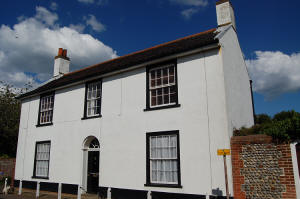
Cowper House, Mundesley
At Bacton the cliffs subside - but then reappear for
one final time at
Happisburgh. Stuck on an
exposed section of the coast, Happisburgh has born the
brunt of coastal erosion for many years. Despite
groynes and rocks and other sea defence schemes large
chunks of land have been disappearing. The houses on Beach
Road were demolished in 2012 and even the doughty Mrs Nierop-Reading who stayed on finally had to abandon
her beloved cliff-top chalet in 2013. Beyond
Happisburgh lies Cart Gap and the lost village of
Eccles-on-Sea. For many years
Eccles church tower stood on the beach before finally
being washed away by the sea. The village
is commemorated by Anthony Thwaite's fine poem Eccles.
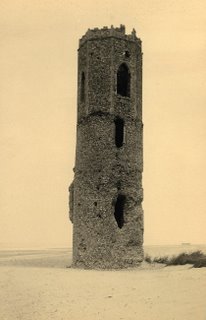
Eccles Church Tower
From Eccles onwards the Norfolk coast is dominated by sand dunes.
Held together by marram grass - the dunes provide a
barrier of sorts against the sea but are always
vulnerable to breaches. The worst of these breaches in
recent history occurred in 1953 when the sea burst
through at
Sea Palling destroying
homes, inundating farmland and killing seven people.
Today the sea remains a constant threat to this part of
Norfolk:
|
|
The sea will always triumph
Tomorrow or today
Despite Norwegian rocks here
Will always find a way
For the sea knows no time
Only deepness and cold
No clocks or watches
For the sea is very old
|
|
Horsey, with its iconic
windmill is another location under threat from the sea.
The poet John Betjeman knew Horsey well from boating
holidays on the Broads and it features in his
East Anglian
Bathe where he recalls walking from the staithe,
swimming in the sea and Horsey Mere.
|
Oh when the early
morning at the seaside
Took us with hurrying steps from Horsey Mere
To see the whistling bent-grass on the leeside
And then the tumbled breaker-line appear, |
|
Winterton has always had a
reputation as a dangerous place for shipping. The author Daniel Defoe
dedicates a long section to it in his A Tour Through
the Whole Island of Great Britain and it is off
Winterton Ness that Robinson Crusoe
experiences his first shipwreck.
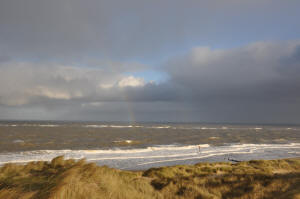
Winterton Ness
Beyond Winterton lie the seaside resorts of Hemsby, Scratby and California
with their holiday chalets and caravans and amusement
arcades. Then comes Caister-on-Sea -
where the Paston family had their castle and where in
the 15th Century the stout-hearted Margaret Paston saw
off an armed raid while her husband was in London. The
last large town on the Norfolk coast is
Great Yarmouth.
Today, it is a holiday destination - famous for its
Pleasure Beach and attractions - but not so long ago
it was a thriving fishing port where herring boats
packed the quaysides. And it was the smell of fish
which permeated the air when David Copperfield first
arrives here - in Charles Dickens' famous autobiographical
novel.
|
|
'When we got into the street (which
was strange enough to me), and smelt the fish, and
pitch, and oakum, and tar, and saw the sailors walking
about, and the carts jangling up and down over the
stones, I felt I had done so busy a place an injustice;
and said as much to Peggotty, who heard my expressions
of delight with great complacency, and told me it was
well known (I suppose to those who had the good fortune
to be born Bloaters) that Yarmouth was, upon the whole,
the finest place in the universe.' |
On the other side of the River Yare the coastline
arrives at Gorleston - which
was once part of Suffolk. From here sandy beaches run
next to the promenade and the links course until we
reach Hopton and the start of Suffolk proper. Behind us
now lies the entire curve of Norfolk - like a 'land of
lost content'. |
Links:
More Photographs of the Norfolk Coast
Photographs of Coastal Erosion in Norfolk
|
|
|
|

